10 Ways Nature Heals: Your Pathway to Inner Peace
Ever notice how your shoulders drop after a walk in the woods? That’s not just you – science shows that even 20 minutes in nature reduces stress hormones by 21%.
Your body knows what your mind often forgets: nature healing isn’t some woo-woo concept, it’s biological.
In our screen-dominated lives, finding pathways to inner peace might seem complicated. But the simplest solution has been around longer than humans have – the natural world surrounding us.
What if reconnecting with nature isn’t just nice but necessary? The 10 approaches I’m about to share transformed my own anxiety-filled life when medication couldn’t. And the strangest part? The most powerful one requires absolutely zero special equipment.
The Science Behind Nature’s Healing Power

How green spaces reduce stress hormones
Ever notice how your shoulders drop after walking in a park? That’s not just in your head. Your body is literally changing its chemistry.
When you step into a green space, your cortisol levels—that’s your primary stress hormone—take a nosedive. Research shows just 20 minutes in nature can significantly lower these stress markers in your bloodstream.
The Japanese call this “shinrin-yoku” or forest bathing, and they’ve been measuring these effects for decades. Participants consistently show decreased cortisol, lower blood pressure, and reduced sympathetic nerve activity (that’s your fight-or-flight response) after forest walks.
The best part? You don’t need a wilderness expedition. Urban parks, community gardens, even a tree-lined street can trigger these physiological changes.
Nature’s impact on brain chemistry
Nature doesn’t just calm your stress hormones—it actually rewires your brain.
When you’re surrounded by natural settings, your prefrontal cortex (the brain’s command center for worry and rumination) gets a much-needed break. Meanwhile, parts of your brain associated with pleasure, empathy, and emotional stability light up.
Studies using EEG measurements show increased alpha wave activity—those brain waves associated with relaxation and creativity—when people simply view natural scenes.
Your brain also releases more serotonin and dopamine during nature exposure, the same feel-good chemicals targeted by many antidepressants. The difference? Nature provides these benefits without side effects.
The evolutionary basis for nature’s calming effect
Our bodies respond to nature because, well, we evolved there.
The biophilia hypothesis, pioneered by E.O. Wilson, suggests humans have an innate tendency to connect with nature because it was essential for our survival. For 99% of human history, we lived intimately with the natural world, developing biological responses that favored those who could find safe, resource-rich natural environments.
Those ancient neural pathways are still active today. When you see the fractal patterns of a fern or hear water bubbling over rocks, your nervous system recognizes these as signals of safety and abundance.
Some researchers call this “soft fascination”—nature captures your attention gently without demanding intense focus, allowing mental restoration. That’s why a beach sunset feels both captivating and calming simultaneously.
Forest Bathing: More Than Just a Walk in the Woods
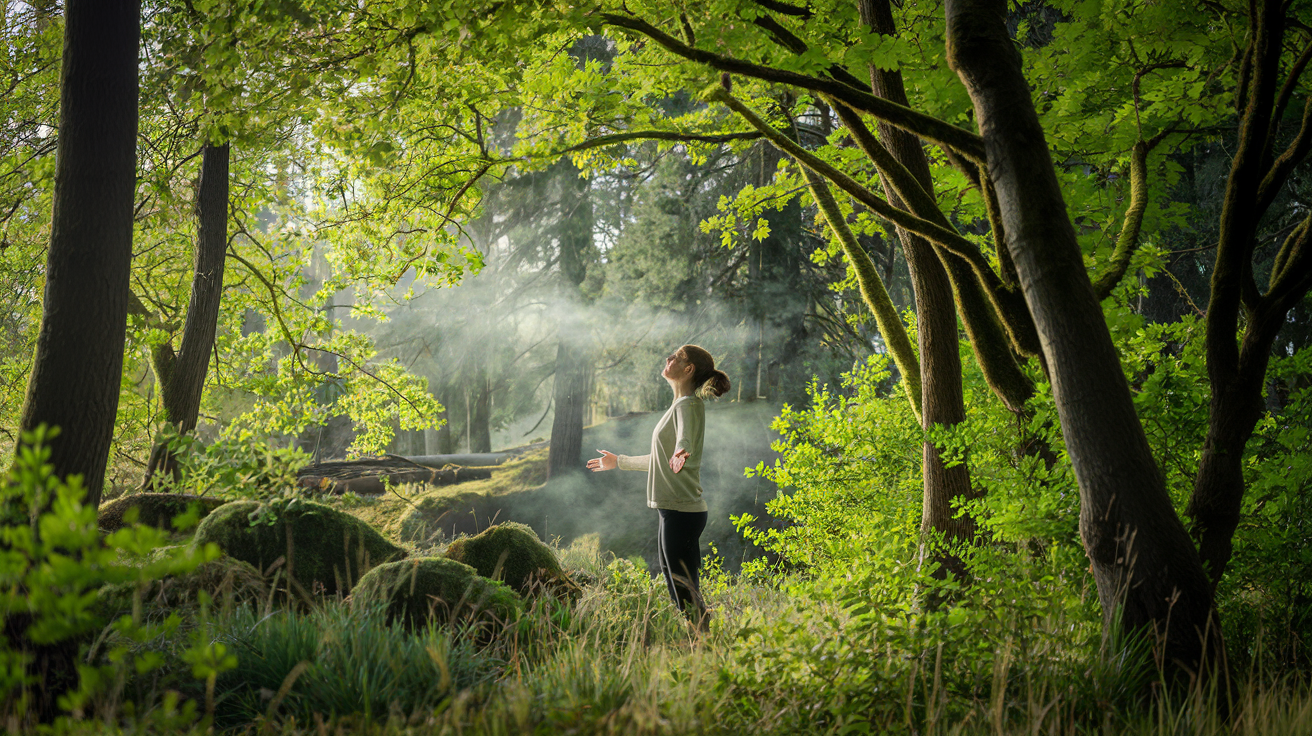
A. Origins of Shinrin-Yoku in Japanese culture
Ever wondered why the Japanese seem to have everything figured out when it comes to wellness? Shinrin-yoku, or “forest bathing,” emerged in Japan during the early 1980s as an antidote to tech-boom burnout and urban stress. The Japanese Ministry of Agriculture, Forestry, and Fisheries actually coined the term in 1982, making it an official part of their national health program.
Unlike hiking, which focuses on destination, forest bathing is about immersion. The Japanese have long revered forests as sacred spaces, with ancient Shinto beliefs holding that gods inhabit natural elements. This cultural reverence transformed into a modern health practice that’s now backed by science.
B. Proven health benefits of forest air
The air in forests isn’t just fresher – it’s medicine. Trees release phytoncides, organic compounds that boost our immune systems in remarkable ways. Studies show just two hours of forest bathing increases natural killer cell activity by up to 50% for a week afterward.
What happens to your body in the forest:
- Blood pressure drops significantly
- Cortisol (stress hormone) levels decrease by 12.4%
- Heart rate variability improves, indicating better cardiac health
- Concentration and memory improve by nearly 20%
The microbiome of forest soil also plays a role. Breathing in these diverse microorganisms strengthens our own microbiome – nature’s probiotics at work.
C. Simple techniques to maximize your forest bathing experience
Forest bathing isn’t complicated, but there are ways to deepen the experience:
- Leave the tech behind. Seriously, your Instagram followers can wait.
- Slow down to forest speed. Aim for less than a mile in two hours.
- Engage all senses. Touch the bark, smell the earth, taste wild berries (only if you know they’re safe!).
- Practice “wide-angle seeing.” Rather than focusing on specific objects, soften your gaze to take in the entire scene.
The most powerful technique? Simply sitting against a tree for 20 minutes. The Japanese call this “tree leaning” – allowing the tree to literally support you while you absorb the forest atmosphere.
D. Best forests and natural settings for beginners
Not all forests deliver the same experience. For beginners, these settings provide the perfect introduction:
- Old-growth forests with diverse tree species offer the richest phytoncide experience
- Forests near water bodies combine beneficial negative ions from both environments
- Cedar and pine forests emit particularly therapeutic compounds
Great starter locations include the Redwood forests of California, Japan’s Aokigahara Forest, and Olympic National Park in Washington. Even urban parks can work – New York’s Central Park has designated “forest bathing zones” now.
The key is finding a place where you feel safe enough to surrender to the experience. That might be a massive national park or the small woodland behind your neighborhood.
Ocean Therapy: Riding Waves to Emotional Wellness

Why the sound of waves calms the nervous system
Ever noticed how your shoulders drop and your breathing slows down when you hear ocean waves? It’s not just your imagination.
The rhythmic pattern of waves crashing on shore creates what scientists call “pink noise” – a type of sound that helps synchronize our brain waves and lower cortisol levels. Unlike the jarring sounds of city life, wave patterns match our natural breathing rhythm, essentially giving our overstimulated brains a break.
My friend went through a brutal divorce last year and spent a week at the coast. She told me, “I couldn’t sleep for months, but that first night by the ocean, I slept like a baby.”
This isn’t rare. Studies show that just 20 minutes of wave sounds can reduce anxiety as effectively as some meditation practices.
The negative ion effect on mood and energy
The ocean is basically a giant negative ion factory, and that’s fantastic news for your mood.
When waves crash, they break water molecules apart, creating negatively charged ions that we breathe in. These microscopic particles increase serotonin production – yes, the same happiness chemical that antidepressants target.
People who live coastside report 40% fewer symptoms of depression compared to inland dwellers. That post-beach euphoria isn’t just from the sunshine and rest – you’re literally breathing in mood-enhancing particles.
Water-based activities for stress relief
The ocean offers more than passive healing – it’s a playground for active recovery:
- Surfing: Combines mindfulness with physical challenge as you focus completely on reading waves
- Float therapy: Simply bobbing in saltwater reduces muscle tension and blood pressure
- Beachcombing: The gentle walking combined with treasure-hunting creates a natural state of flow
- Cold water immersion: That initial shock of cold ocean water triggers endorphin release that can last hours
Even wading ankle-deep changes your nervous system response. The pressure of water against your body creates a gentle compression effect similar to a weighted blanket.
Mountain Mindfulness: Finding Perspective in High Places

How Altitude Changes Shift Mental Perspectives
Ever notice how problems seem smaller when viewed from up high? That’s not just poetic imagery—it’s your brain responding to elevation. When you climb a mountain, you’re not just changing your physical position but your mental one too.
The higher you go, the more your brain enters a state of expanded awareness. Research shows that being physically elevated actually helps us think more abstractly and see the bigger picture. Your daily worries—that work deadline, the argument with your friend—suddenly don’t seem so all-consuming when you’re staring at an endless horizon.
Mountains literally force us to rise above our usual thinking patterns. The climb itself becomes a metaphor: tackling one step at a time, persisting through difficulty, and reaching new heights of understanding.
The Psychology of Awe in Mountain Settings
Mountains aren’t just big rocks—they’re awe machines. That stomach-dropping feeling when you first glimpse a massive peak? That’s awe in action, and it’s incredibly powerful medicine for your mind.
Awe fundamentally changes how we perceive ourselves. When faced with something so much larger and older than us, our sense of self literally shrinks while our connection to something greater expands. Scientists call this “the small self effect,” and it’s particularly potent in mountain environments.
This isn’t just feel-good talk. Studies show that experiencing awe:
- Reduces inflammatory markers in the body
- Increases feelings of generosity and compassion
- Enhances critical thinking abilities
- Reduces impatience and extends our perception of time
Mountains trigger this response more reliably than almost any other natural setting. Their sheer scale forces a perspective shift that’s nearly impossible to ignore.
Mountain Meditation Practices for Inner Strength
The stillness of mountains offers the perfect backdrop for meditation practices that build mental resilience. Try these mountain-specific techniques:
Summit Sitting: Find a safe spot with a view. Sit firmly, imagining your body has the stability of the mountain beneath you. When thoughts arise (and they will), picture them as passing clouds that don’t disturb the mountain’s core.
Breathing with Elevation: As you inhale, visualize drawing strength from the mountain’s base through your feet and up your spine. As you exhale, release tension downward into the earth.
Ridge Walking: A moving meditation where each step is deliberate and mindful. Focus only on the ground immediately before you, the sensation of each footfall, and your breath syncing with movement.
These aren’t random practices. They’re designed to help you internalize the mountain’s qualities: stability amidst changing conditions, patient endurance, and quiet strength.
Preparing for Your First Mindful Mountain Experience
Want to try mountain mindfulness but feeling overwhelmed? Start small. You don’t need Everest to experience transformation.
Pack these essentials for a mindful mountain day:
- Journal for recording insights
- Comfortable seating pad
- Water and simple snacks that won’t distract
- Weather-appropriate layers (being cold or wet makes mindfulness nearly impossible)
- A specific intention for your practice
The key is preparation without expectation. Set yourself up for comfort, but don’t demand a specific experience. Mountains reveal their wisdom on their own timeline, not yours.
Begin with shorter trips to accessible viewpoints rather than ambitious summit attempts. The goal isn’t physical conquest but mental presence.
Safety Considerations While Seeking Solitude
The solitude mountains offer is precious—but it comes with responsibilities. Finding peace shouldn’t mean putting yourself in danger.
Mountains demand respect. Always:
- Tell someone where you’re going and when you’ll return
- Check weather forecasts obsessively (conditions change rapidly at elevation)
- Carry emergency supplies even for “easy” trips
- Know your physical limits and honor them
- Consider joining a guided mindfulness hike for your first experience
Remember that true mindfulness includes awareness of your surroundings and situation. Paying attention to changing weather, trail conditions, and your body’s signals isn’t being paranoid—it’s practicing mountain awareness at its most fundamental level.
The safest solitude often comes from finding less-traveled spots rather than remote ones. A quiet corner of a popular trail system gives you peace while keeping help within reach if needed.
Gardening as Meditation: Growing Your Inner Peace

The therapeutic touch of soil
Ever noticed how your stress melts away when your fingers dig into warm earth? There’s something magical happening there. Soil contains microbes that actually trigger serotonin release in your brain – the same feel-good chemical that antidepressants target.
I started gardening during my darkest bout of anxiety, and within weeks, I felt a shift. Science backs this up. Studies show that a harmless soil bacteria called Mycobacterium vaccae activates brain cells that produce serotonin.
But it’s not just chemistry. The sensory experience grounds you – literally. The earthy smell, the varied textures between your fingers, the immediate connection to something real and alive. When everything else feels chaotic, soil remains constant and patient.
Try this: next time you’re overwhelmed, step outside and just plant something. Anything. Notice how your breathing naturally slows as you focus on this simple, nurturing task.
Mindful gardening practices for anxiety relief
Gardening isn’t just about growing plants – it’s about growing peace within yourself. The key? Mindfulness.
Start small. Choose one plant to become your meditation partner. When watering it, focus completely on the water’s path – from can to soil to roots. When thoughts intrude (they always do), gently return to the sensory experience.
Morning gardening rituals work wonders. Before the day’s demands pile up, spend 15 minutes with your plants. Check new growth, remove dead leaves, or simply observe. This creates a buffer between sleep and stress.
Try task-focused sessions: weeding becomes a practice in letting go, pruning teaches necessary boundaries, and transplanting reminds us that change brings growth.
Plants that enhance mood and promote relaxation
Not all green friends are created equal when it comes to calming effects. Some plants actively help your mental state.
Lavender isn’t just pretty – inhaling its scent lowers heart rate and blood pressure. Place it where you’ll brush against it daily.
Jasmine improves sleep quality and reduces anxiety. Studies show its scent has effects similar to valium, but without the side effects or grogginess.
Rosemary improves memory and concentration – perfect for those anxiety-induced brain fog moments.
Snake plants and peace lilies don’t just look cool – they clean your air of toxins while requiring minimal care, making them perfect low-stress companions.
The best part? Watching these plants thrive under your care creates a powerful metaphor for your own healing journey. As they grow stronger, so do you.
Wildlife Connection: Learning from Animal Wisdom

How observing animals teaches presence
Ever watched a fox hunt in the snow? Total focus. Nothing else exists. That’s presence in its purest form.
Animals don’t worry about tomorrow’s weather or yesterday’s missed opportunities. They’re fully immersed in now. When you observe wildlife, you’re witnessing masters of mindfulness at work.
I started sitting quietly at my local park last year. Just watching squirrels taught me more about being present than a dozen meditation apps. They don’t check their phones every five minutes or worry about unanswered emails.
Try it yourself. Find a comfortable spot outdoors. Just watch. Notice how birds respond instantly to sounds you barely register. See how deer become completely still, their senses heightened to everything around them.
Ethical wildlife interaction for emotional healing
Wild animals aren’t therapists with fur. They’re living beings deserving respect.
The healing comes from connection, not interference. Proper distance isn’t just for their protection—it’s for authentic observation. When you manipulate wildlife, you’re not seeing their true nature.
Some ethical approaches:
- Visit sanctuaries that prioritize animal welfare
- Participate in citizen science projects
- Use binoculars instead of approaching closely
- Learn tracking instead of baiting animals
The emotional benefits multiply when you know your presence isn’t causing harm. There’s profound healing in witnessing without disturbing.
Creating backyard habitats for daily nature connection
You don’t need a forest to connect with wildlife. Even apartment dwellers can create tiny ecosystems.
Native plants on a balcony will attract pollinators. A simple bird feeder brings winged visitors daily. Water sources—even small ones—become wildlife magnets.
The magic happens when these spaces become part of your routine. Morning coffee while watching hummingbirds. Evening unwinding as bats emerge at dusk.
Your backyard habitat becomes a living classroom for nature’s rhythms. You’ll notice seasonal patterns, regular visitors, and unexpected moments of wild beauty.
Learning patience through birdwatching
Birdwatching will humble you fast. The first lesson isn’t about birds—it’s about slowing down.
Experienced birders know the secret: patience isn’t waiting for something to happen. It’s being fully engaged with what is happening, even when it seems like nothing.
Birds operate on their schedule, not yours. They appear when conditions are right, not when you’ve decided to look for them. This forced surrender teaches profound patience.
The reward isn’t just spotting a rare species. It’s developing a quality that enhances everything else in life. The patience cultivated watching for an elusive warbler transfers to dealing with traffic jams, long lines, and life’s inevitable delays.
Natural Soundscapes: Acoustic Healing for Modern Minds
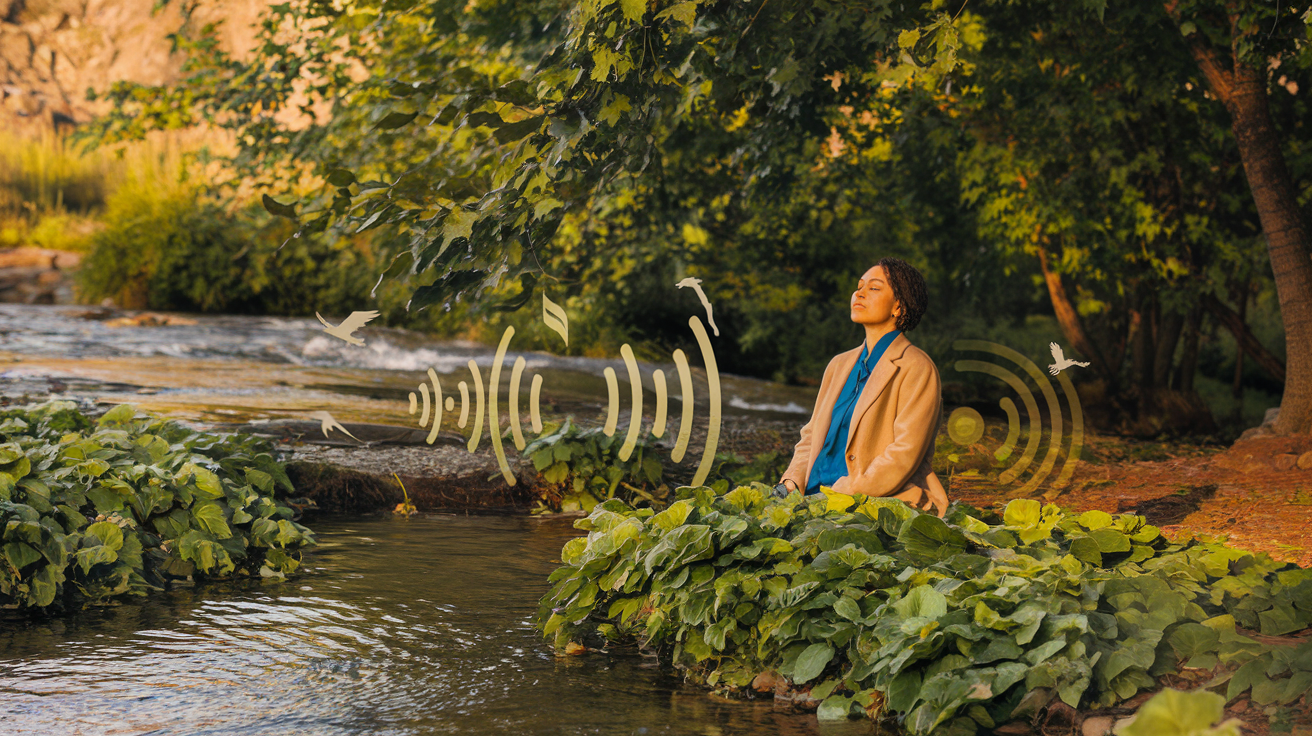
The impact of natural sounds on brain waves
Ever noticed how the sound of rainfall makes you sleepy? That’s your brain waves shifting gears.
Natural sounds literally change how your brain functions. When you hear waves crashing or leaves rustling, your nervous system responds by decreasing cortisol (that pesky stress hormone) and activating your parasympathetic system – your body’s built-in relaxation response.
Studies show that natural soundscapes trigger alpha brain waves, which appear when you’re in a state of wakeful rest. This is exactly why a babbling brook sounds so much better than a honking car horn – one pushes your brain toward calm, the other toward fight-or-flight.
The most interesting part? Your brain processes natural sounds differently than artificial ones. Nature sounds don’t demand your attention – they allow your mind to wander and reset in ways city noise never can.
Creating a nature sound sanctuary at home
You don’t need a forest in your backyard to benefit from nature’s soundtrack.
Start small – open windows when possible to let natural ambient sounds in. Even urban birds can provide healing acoustic benefits.
For a dedicated sanctuary:
- Place a small indoor fountain in your living space
- Position wind chimes near windows
- Use houseplants that rustle with air movement
- Consider a white noise machine with authentic nature recordings
The secret is consistency. Even 15 minutes daily in your sound sanctuary can reset your nervous system and improve your mood.
Using recorded nature sounds for sleep and focus
Nature recordings aren’t just for relaxation apps.
For sleep, ocean waves and gentle rainfall work wonders because they match your heart’s resting rhythm. The consistency helps your brain transition to deeper sleep stages.
For focus and productivity, try:
- Birdsong for creative work
- Flowing water for analytical tasks
- Gentle wind for reading or studying
The trick is finding sounds that fade into the background without jarring elements. That sudden thunderclap might break your concentration rather than enhance it.
Many people report better sleep quality, improved focus, and reduced anxiety after incorporating nature sounds into their daily routines. Your brain evolved with these sounds for millennia – it makes sense they still hold power to heal our overstimulated modern minds.
Seasonal Alignment: Synchronizing with Nature’s Rhythms
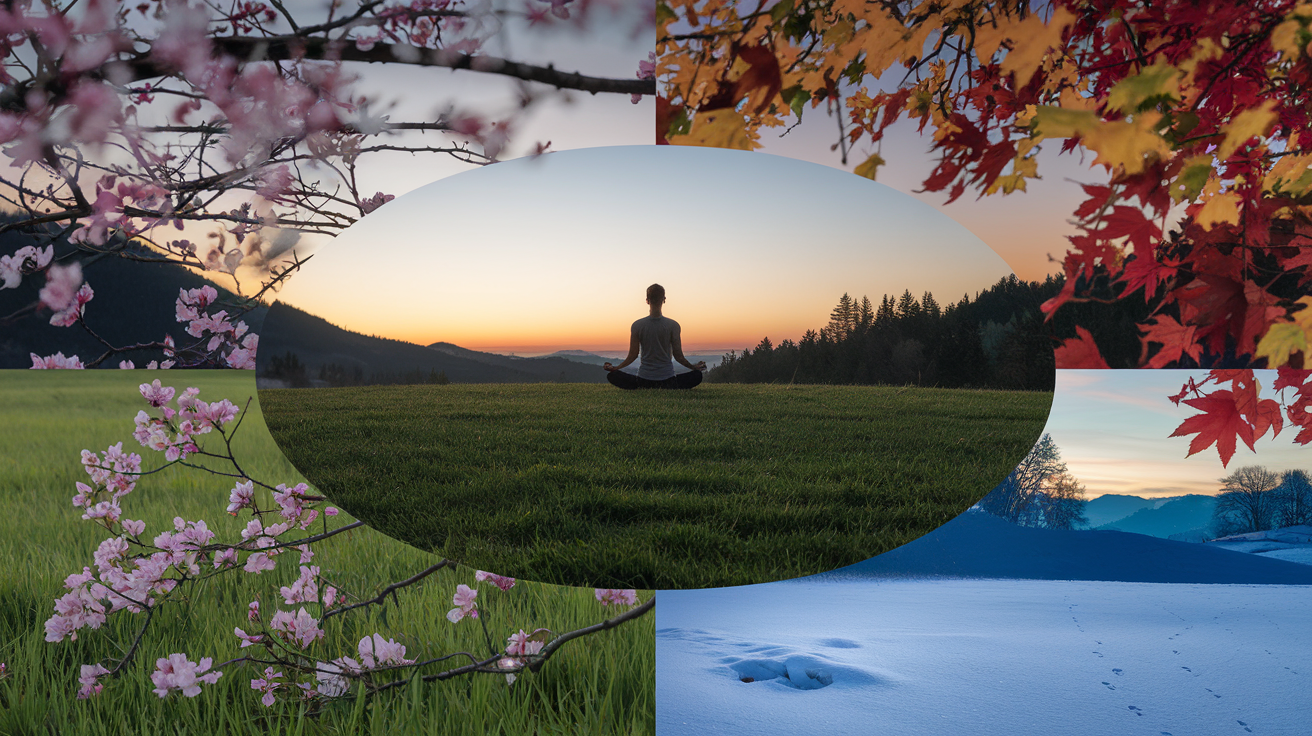
Healing Benefits of Seasonal Awareness
Ever notice how your mood shifts with the seasons? There’s a reason for that. Our bodies are naturally wired to sync with nature’s calendar.
When you tune into seasonal rhythms, you’re not just following a trend—you’re tapping into ancient wisdom. Your body knows what it needs in summer versus winter.
The benefits are real:
- Better sleep cycles when you align with natural light patterns
- Improved immune function when eating seasonal foods
- Reduced stress when you stop fighting against nature’s pace
- Enhanced energy levels that flow with the season’s natural energy
Think about it. Winter naturally calls us to rest more, while summer energizes us for activity. Working with these patterns instead of against them is like swimming with the current instead of exhausting yourself fighting it.
Practices for Each Season to Maximize Well-being
Spring
- Morning walks to absorb the increasing daylight
- Gentle detoxification through fresh greens and increased water
- Decluttering your space to mirror nature’s new growth
Summer
- Early morning or evening outdoor activities to avoid heat stress
- Cold plunges or swimming in natural waters
- Grounding practices like barefoot walking on earth or grass
Fall
- Harvesting practices—literally or metaphorically gathering what you’ve grown
- Establishing comforting rituals as daylight decreases
- Forest walks to witness the beautiful surrender of leaves
Winter
- Embracing earlier bedtimes and later risings
- Nourishing practices like warm baths and hearty, slow-cooked meals
- Reflection and inner work during nature’s quiet time
Overcoming Seasonal Affective Disorder Naturally
Winter blues hitting hard? You’re not alone. Seasonal Affective Disorder affects millions, but nature offers solutions.
Morning light exposure is your first defense. Even on cloudy days, 20 minutes outdoors within an hour of waking can reset your circadian rhythm.
Try these natural approaches:
- Light therapy using full-spectrum lights that mimic natural sunlight
- Winter exercise routines, especially outdoors when possible
- Vitamin D supplementation (with healthcare provider guidance)
- Cold exposure therapy—brief cold showers or winter swimming for the brave
- Nature connection even in winter—tracking animals, identifying trees without leaves
The key is consistency. Small daily practices maintain your connection to nature’s cycles even when you’d rather hibernate under blankets.
Remember, our ancestors navigated seasonal changes without modern conveniences. Their wisdom lives in our bodies—we just need to listen.
Eco-Therapy: Structured Nature Healing Programs
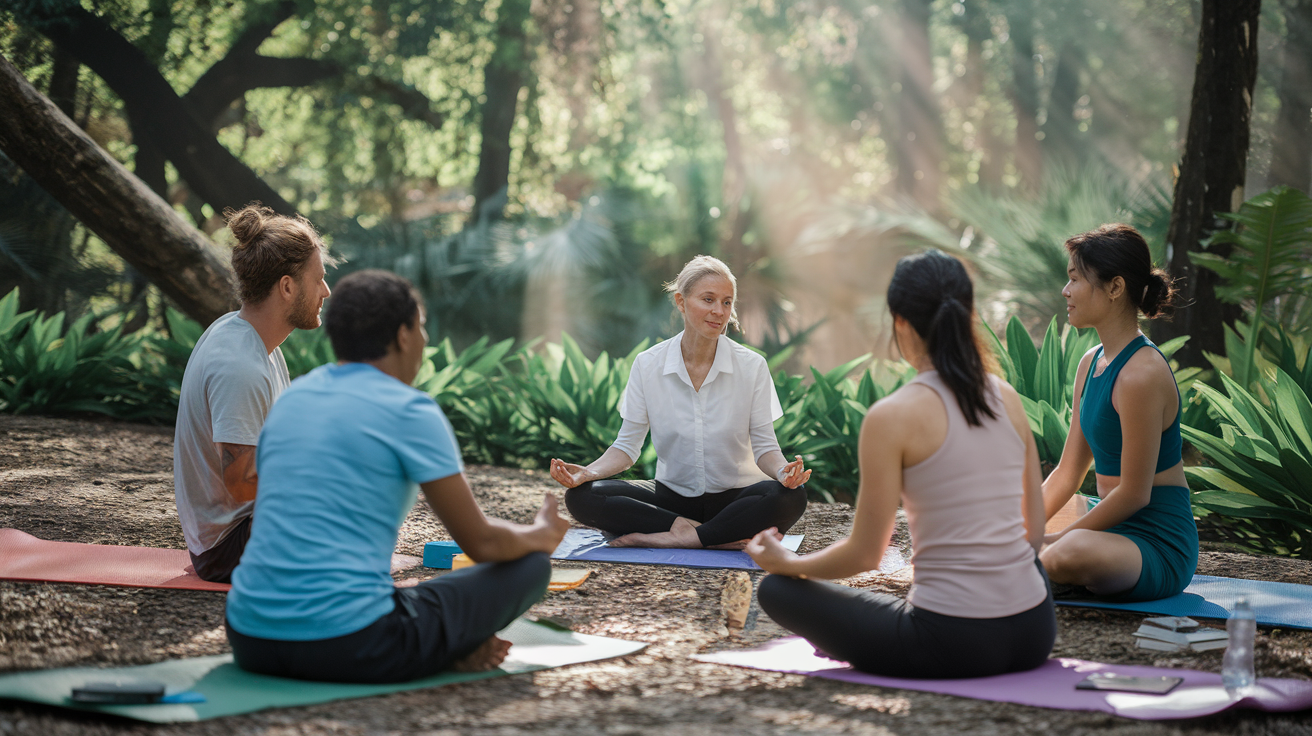
Finding Qualified Nature Therapy Guides
Ever noticed how some guides just get it while others miss the mark completely? When looking for an eco-therapy guide, credentials matter. Search for professionals certified by the Association of Nature and Forest Therapy or similar organizations. But honestly? The best guides combine formal training with that special something – genuine passion for connecting people with nature.
Ask potential guides about their approach. Do they rush through experiences or allow for genuine moments of connection? A good guide creates space for your personal journey rather than forcing specific outcomes.
Don’t just take their word for it. Check reviews, ask for references, or try a sample session before committing to a program.
What to Expect in a Guided Eco-Therapy Session
First time? No worries. Most sessions begin with a simple invitation to disconnect from devices and connect with your surroundings. Your guide might lead you through:
- Sensory awareness exercises (feeling the texture of bark, listening to distant sounds)
- Mindful walking at a snail’s pace (yep, that slow)
- Sitting spots where you observe nature from one location
- Guided meditations that incorporate natural elements
- Group sharing circles (totally optional if that’s not your thing)
Sessions typically last 2-3 hours, though some intensive programs run full days. Wear comfortable clothes and come with an open mind.
DIY Eco-Therapy Exercises for Daily Practice
Can’t access a guide? No problem. Try these simple practices:
-
Five Senses Inventory: Spend 15 minutes noting one thing you see, hear, smell, feel, and taste (if safe) in nature.
-
Gratitude Stone: Find a small stone, hold it while thinking of three things in nature you’re grateful for, then carry it in your pocket.
-
Sit Spot Practice: Visit the same natural location regularly, just observing changes over time.
-
Nature Journaling: Document observations, feelings, and insights from your outdoor experiences.
These aren’t just nice-to-dos – they’re practical tools that build your nature connection muscles.
Measuring Your Progress with Nature Connection
Progress isn’t always linear, but you’ll know it’s happening when:
- You notice subtle details in natural settings that previously escaped your attention
- Your stress levels drop more quickly during outdoor time
- You develop a deeper sense of place and belonging in natural environments
- Your sleep quality improves
- You find yourself craving nature time rather than seeing it as another obligation
Consider keeping a simple 1-10 scale journal rating your mood before and after nature time. The numbers rarely lie.
Some people also track physiological markers like blood pressure or heart rate variability, but the most meaningful measure is often your intuitive sense of wellbeing.
Digital Detox in Natural Settings: Reclaiming Mental Clarity

How Technology Interferes with Nature’s Benefits
Ever noticed how that nagging urge to check your phone ruins perfectly good moments in nature? You’re not alone. Our devices have become digital leashes, keeping us tethered to work stress and social drama even when we’re surrounded by healing natural beauty.
Studies show the average American checks their phone 96 times daily. That’s once every 10 minutes! When we bring this habit into natural settings, we block the very benefits we came for. Your brain can’t fully engage with the calming rustle of leaves or the rhythmic ocean waves when it’s constantly interrupted by notifications.
The blue light from screens also messes with your melatonin production, which nature typically helps regulate. So that sunset hike you took to improve your sleep? Kinda pointless if you’re snapping and scrolling the whole time.
Planning the Perfect Nature-Based Digital Detox
Start small. A two-hour phone-free hike feels more doable than a week-long tech blackout. Pick a stunning location that naturally pulls your attention away from devices – a waterfall, mountain vista, or secluded beach.
Pack differently:
- Bring a real camera instead of using your phone
- Pack a physical map rather than Google Maps
- Take a journal to record thoughts instead of social media
- Bring field guides for identifying plants/wildlife
Tell people you’ll be unreachable. Set an away message. Then turn everything off – not just on silent or airplane mode. Off.
Transitioning from Digital Overload to Natural Awareness
The first 30 minutes are the hardest. Your brain will crave that dopamine hit from notifications. Push through it.
Try these transition techniques:
- Deep breathing exercises focusing on natural scents
- Count different bird songs you can hear
- Feel different textures – rough tree bark, smooth stones, soft moss
- Follow a single cloud’s journey across the sky
Your awareness will gradually shift. Colors become more vivid. Sounds more distinct. That mental chatter quiets down.
What you’re experiencing is your nervous system downshifting from fight-or-flight to rest-and-digest mode – exactly what nature intended before we introduced the constant digital stimulation that hijacks our attention and stress responses.
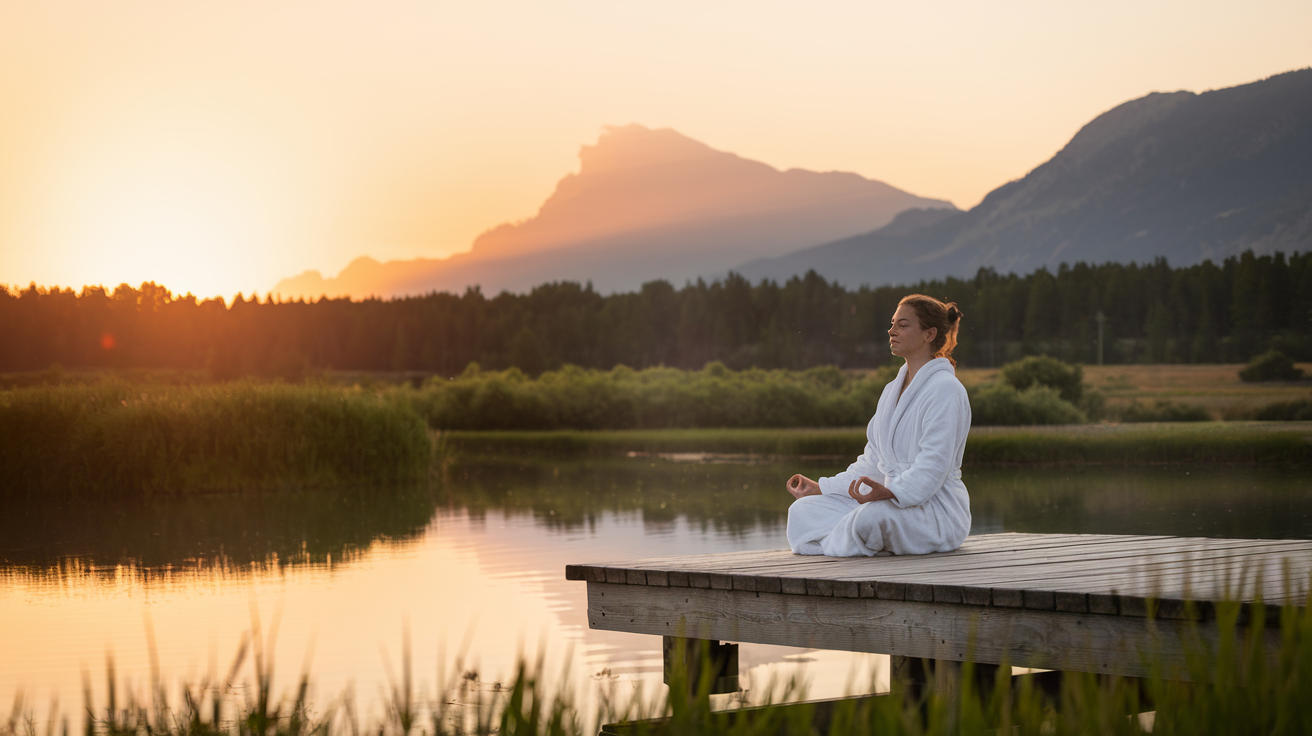
Nature’s healing power extends far beyond mere relaxation, offering scientifically proven pathways to inner peace through diverse experiences. From the stress-reducing effects of forest bathing and the emotional release of ocean therapy to the perspective gained in mountains and the mindful practice of gardening, the natural world provides countless opportunities for restoration. Wildlife encounters teach us valuable life lessons, while natural soundscapes soothe our overstimulated minds and aligning with seasonal rhythms grounds our existence.
As you navigate life’s challenges, consider incorporating these natural healing modalities into your routine. Whether through formal eco-therapy programs or simply disconnecting from technology in natural settings, the pathway to inner peace lies just beyond your doorstep. The earth has always held the medicine we need—it’s time to reconnect and allow nature to work its healing magic on your mind, body, and spirit.






https://shorturl.fm/bODKa
https://shorturl.fm/nqe5E